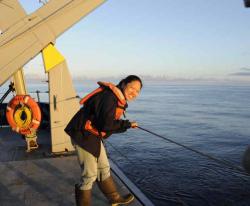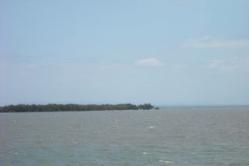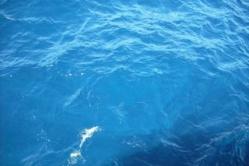Upon arrival on the Melville, Liz was terribly sick so she was off to bed (see other journal entry). I went out to party with some members of the science team, all of whom were strangers still (except Jack, other UNH student), since I had just dropped my bags off on board and went back to downtown Brisbane. They all had the week to get to know each other (plus they had to load everything on to the ship). Lesson learned: try to arrive earlier. Nevertheless, I had a great time getting to know them on the dance floor at a jazz bar where Bill (science team) played the sax at a blues/jazz bar. (See pics in Karen's entry!) On the first day, I was inundated with unfamiliar terminology. Alison had a meeting with the CTD student watch standers, and we realized we were all clueless about our responsibilities. I thought we were going to measure conductivity, temperature, and depth, but apparently it is much more complicated! We actually handle the logistics of collecting seawater at certain depths, and distributing them to the different parties who process them for different types of measurements. This involves preparing the bottles of the rosette, helping the resident technician send the rosette on and off the ship, checking all the instruments while it is brought down to the bottom depth and up to the surface, tripping the bottles (closing them) at the desired depths on their way up, and making sure people go in order when they take water samples. Of course on our first tries, we were nervous and clumsy (or at least I was..I hope nobody posts that picture of me trying to cock that first bottle, I looked like I was attacking the thing and my hair was flying all over the place). After several repetitions, we've definitely gotten better at it despite all the mishaps at Station 3 (took us 6 times to get it!). Manning the console (tripping bottles and checking instruments) is a pretty big responsibility. The rosette is a 200,000-dollar piece of equipment (says Keith, resident technician). We want to try to get it down all the way to the bottom, but if we actually hit the bottom, we can damage the rosette or ruin the samples with silt. Sometimes there's electrical problems and of course, we have no idea how any of this stuff works. But that's why we have the res. techs running the show. It's slowly becoming less stressful for me. Seeing the real-time data is exciting too, because I just went over profiles of elemental and other oceanographic properties with my students from Introduction to Oceanography (I'm a TA). When we see them in the textbook or the lectures, it's difficult to consider all the work that goes into getting the data, and all the variables that could affect the results. And it's fun to point out things that I know of, like the oxygen minimum zone, which has occurred at just about 1000 to 1500 m around these parts (just north of New Zealand around 30 S 157 E). The OMZ has denitrifying bacteria that convert NO3 to N2 gas. Seeing everyone collect the water from the bottles once the rosette is brought up onto deck is exciting when you realize how expensive and exotic the water is. The first bottle is from the bottom of the ocean!! It may be 1600 years old! It's extremely cold compared to the last bottles from the surface. When this goes on, everyone is bumping into each other trying to quickly get water from the different bottles; it's pretty chaotic as there are probably at least 10 people who want samples from every bottle of the rosette. But I really enjoy this part, because it makes me appreciate the simple notion that we have capabilities to do such a thing and generate science out of it. I think my favorite thing so far is just having conversations with everyone, because these are the times when I learn the most. From Alison, the chief scientist, I learned how all the data is used (it's used as hydrography, which is input data, for models of ocean circulation), and how different institutions are funded and started. From the Mary, (ODF) and Rob (Res. Tech.), I've learned how all the equipment works. From Dave, I learned how the ship works and where everything is (generators and engines at the bow, connected by a shaft to the electric motors in the back, which start the propellers). From my conversations with the students and water sample processors, I was introduced to new professions I've never heard of, and started to imagine what it would be like to do be at sea all year round. From the trace metal guys (Chris Measures, Jack, Bill, and Max), I've learned how they measure Al and Fe from 1000 meters to the surface. Al is done by fluorometer with an indicator, and Fe by spectrophotometer. My view of the ocean I got a kick out of how the water went from brown to turquoise to cerulean blue as we started moving away from shore (My specialty is in ocean color). Right now, everywhere around me is pure cerulean blue underneath a clear blue sky. The seawater is almost like a dark Gatorade blue. And depending on where the sun is overhead, there are rays of cyan emanating to the surface from one point, like how rays of sunlight pierce through clouds during a sunset or sunrise, only up-side down. The sunrises and sunsets, of course, have been breathtaking, and they're definitely a nice break for some who have been processing samples (ss,dd --same sh*t, different day, as I was told). My nerdy view of the ocean Currently, I am trying to observe and understand the ocean's color at different angles, which changes with the solar zenith angle (direction of the sun). I've noticed that at dawn, the light scatters with an uniform spectrum (grey) when I look towards the sun, and scatters blue when I look directly away from it, which makes sense. Then bands of blue and grey alternate around me between the to and fro directions, and they change directions as the sun moves overhead. There are also diamond-like specs everywhere, which is the strong scattering with a uniform spectrum (white), at the tops of waves before they break. I presume this is the stuff that is normalized when a satellite measures the radiance (the ocean's color). Or perhaps it is not even a problem since they do not observe the ocean from such a small angle. I realize from this experience, that I never actually tried to materialize all the ocean optics theory I've been learning. It's having me question my current understanding, which is good. Status Currently, We’re on Station 19 out of 151 stations on the CLIVAR P6 transect. Yesterday night, Rachel (pH bottle sampler) and I went up on O1 Deck to see the stars. It took about half a minute for our eyes to adjust but they started popping up everywhere. We soon realized we were staring at the Milky Way. Last updated: December 26, 2009 | |||||||||||||||||||
Copyright ©2007 Woods Hole Oceanographic Institution, All Rights Reserved, Privacy Policy. | |||||||||||||||||||



